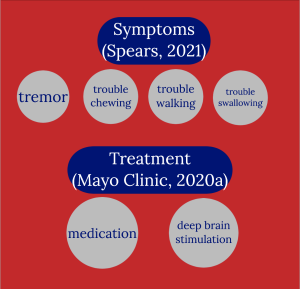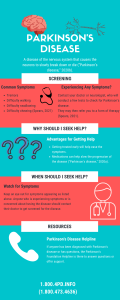Grace West
Introduction
Parkinson’s disease is a disease of the nervous system that causes the nerve cells, called neurons, to slowly break down or die. This is a slow-progressing disease that begins to cause symptoms over many years. When neurons break down, it results in a decrease in dopamine which can cause symptoms such as tremors of the body, stiff muscles, and difficulty thinking, writing, walking, or chewing (Mayo Foundation for Medical Education and Research, 2020b). These symptoms can make life very hard to live without help once they get past a certain point.
Causes and Risk Factors
The cause of Parkinson’s disease is unknown, but some genes have been linked to an increased chance for certain people. The X-chromosome contains a gene that affects how early Parkinson’s disease develops. Females have two X-chromosomes, whereas men have an X and a Y chromosome. A gene may not present itself physically when there is a second X-chromosome. This provides women with more protection against the disease compared to males. Therefore, this may be the reason Parkinson’s develops earlier in males (Mata et al., 2015).

It is found that men are diagnosed more frequently than women. This could be because men are studied more often than women are, so the men have higher numbers (Pagano et al., 2016). Men also reported that they have more symptoms than women did, but they were not as severe as the females’ symptoms were. Though men have more symptoms, women are twice as likely to show tremors or have slowed movement than men are (Miller & Cronin-Golomb, 2010). Studies have also found that Parkinson’s is the most prevalent in Caucasians compared to other ethnicities (Ben-Joseph et al., 2020). Age is also a large factor in who gets Parkinson’s disease. As individual ages, their risk for developing this disease increases (Mayo Foundation for Medical Education and Research, 2020b).
Pagano et al. (2016) found that the age group with the highest number of symptoms is those who are 60 to 69 years old. This age group showed the greatest number of symptoms at the time of diagnosis than others (Pagano et al., 2016). Other risk factors for developing Parkinson’s disease can include having a family member with the disease or being around herbicides and pesticides for long periods of time. While the pesticide and herbicide risk is small, there still needs to be more research to determine the impact (Mayo Foundation for Medical Education and Research, 2020b).
Signs and Symptoms

Though there is no sure way to prevent the disease, there are some early signs that can be checked for to ensure that the individuals are able to get treated quickly. The early signs are the presence of a tremor, trouble moving or walking around, chewing, or swallowing. These symptoms are due to the death of the neurons that control movement, called motor neurons. If anyone recognizes these signs, they must speak to their doctor or neurologist to get tested. When the individual gets diagnosed with Parkinson’s disease, their neurologist or doctor will begin a treatment plan for them, which may include a referral to a physical, occupational, or speech therapist to deal with some of the symptoms (Spears, n.d.).
Treatment
According to the Mayo Clinic (2020a) there is no cure for Parkinson’s disease, however, there are a variety of treatments like medications and deep brain stimulation to slow the progression and severity of symptoms. Medications can be prescribed that help with the patient’s tremors, walking, and other movements. These medications will increase the level of a hormone called dopamine in the brain. This chemical is missing or is present in a lower amount when the neurons die, so the medications give it back to the brain. Deep brain stimulation uses electrodes in the patient’s brain that are connected to a generator in the chest that sends electricity to the brain. This surgery does not keep Parkinson’s disease from getting worse, it only helps the patient’s current symptoms. This surgery involves many risks like stroke, hemorrhage, or infections, so doctors don’t do it very often (Mayo Foundation for Medical Education and Research, 2020a).
Treatments for Parkinson’s allow the patient to manage the severity and progression of their symptoms in order to help with pain or discomfort throughout life. Following diagnosis and treatment, the priority is palliative care to ensure that the patient is comfortable and has the highest quality of life possible (Mayo Foundation for Medical Education and Research, 2020a).
After looking at the symptoms, causes, treatments, and disparities, anyone who is concerned about themselves or others around them having Parkinson’s disease should be ready to go to a doctor if they show any of these symptoms or risk factors.

Chapter Review Questions
1. Parkinson’s disease affects what type of body cell?
A. Nerve cells
B. Muscle cells
C. Immune Cells
D. Epithelial Cells
2. Which age group has the highest rate of diagnosis of Parkinson’s disease?
A. 40-49 years old
B. 50-59 years old
C. 60-69 years old
D. 70-79 years old
3. Parkinson’s disease lowers the level of what hormone in the brain?
A. Serotonin
B. Dopamine
C. Epinephrine
D. Oxytocin
References
Ben-Joseph, A., Marshall, C. R., Lees, A. J., & Noyce, A. J. (2020). Ethnic variation in the manifestation of Parkinson’s disease: A narrative review. Journal of Parkinson’s Disease, 10(1), 31–45. 10.3233/JPD-191763
Mata, I. F., Jang, Y., Kim, C.-H., Hanna, D. S., Dorschner, M. O., Samii, A., Agarwal, P., Roberts, J. W., Klepitskaya, O., Shprecher, D. R., Chung, K. A., Factor, S. A., Espay, A. J., Revilla, F. J., Higgins, D. S., Litvan, I., Leverenz, J. B., Yearout, D., Inca-Martinez, M., … Zabetian, C. P. (2015). The RAB39B p.G192R mutation causes x-linked dominant Parkinson’s disease. Molecular Neurodegeneration, 10(1), 50. 10.1186/s13024-015-0045-4
Mayo Foundation for Medical Education and Research. (2020a, December 8). Parkinson’s disease- diagnosis and treatments. Mayo clinic. https://www.mayoclinic.org/diseases-conditions/parkinsons-disease/diagnosis-treatment/drc-20376062#:~:text=Levodopa%2C%20the%20most%20effective%20Parkinson’s,side%20effects%20such%20as%20nausea.
Mayo Foundation for Medical Education and Research. (2020b, December 8). Parkinson’s disease- symptoms and causes. Mayo clinic. https://www.mayoclinic.org/diseases-conditions/parkinsons-disease/symptoms-causes/syc-20376055.
Miller, I. N., & Cronin-Golomb, A. (2010). Gender differences in Parkinson’s disease: Clinical characteristics and cognition. Movement Disorders: Official Journal of the Movement Disorder Society, 25(16), 2695–2703. 10.1002/mds.23388
Pagano, G., Ferrara, N., Brooks, D. J., & Pavese, N. (2016). Age at onset and Parkinson’s disease phenotype. Neurology, 86(15), 1400–1407. 10.1212/WNL.0000000000002461
Spears, C. (n.d.). 10 early signs of Parkinson’s disease. Parkinson’s Foundation. https://www.parkinson.org/understanding-parkinsons/10-early-warning-signs
A neurotransmitter made in the brain that aids with motor function, mood, and decision making.
A shake in the hands or other parts of the body.
A medical doctor who specializes in treating diseases of the nervous system.
bleeding from a broken blood vessel inside the body
Treatment that is aimed towards decreasing or managing pain and improving quality of life.
